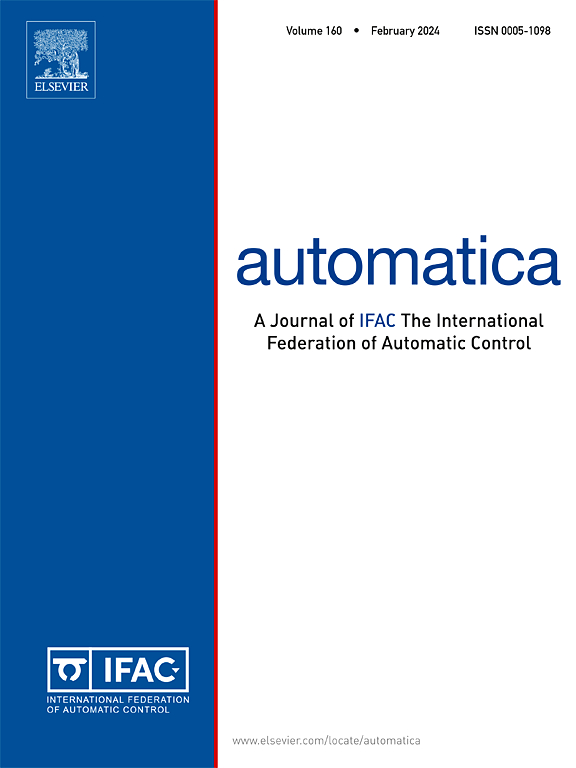Exponential and prescribed-time extremum seeking with unbiased convergence
IF 5.9
2区 计算机科学
Q1 AUTOMATION & CONTROL SYSTEMS
引用次数: 0
Abstract
We present multivariable extremum seeking (ES) designs that achieve unbiased convergence of the inputs to their corresponding optima, eliminating steady-state oscillations. Two designs are introduced: one with exponential unbiased convergence (unbiased extremum seeker, uES) and the other with user-assignable prescribed-time unbiased convergence (unbiased PT extremum seeker, uPT-ES). In contrast to the conventional ES, which uses persistent sinusoids and results in steady-state oscillations around the optimum, the exponential uES employs an exponentially decaying amplitude in the perturbation signal (for achieving convergence) and an exponentially growing demodulation signal (for making the convergence unbiased). The achievement of unbiased convergence also entails employing an adaptation gain that is sufficiently large in relation to the decay rate of the perturbation amplitude. Stated concisely, the bias is eliminated by having the learning process outpace the waning of the perturbation. The other algorithm, uPT-ES, employs prescribed-time convergent/blow-up functions in place of constant amplitudes of sinusoids, and it also replaces constant-frequency sinusoids with chirp signals whose frequency grows over time. Among the convergence results in the ES literature, uPT-ES may be the strongest yet in terms of the convergence rate (prescribed-time) and accuracy (unbiased). To enhance the robustness of uES to a time-varying optimum, exponential functions are modified to keep oscillations at steady state. Stability analysis of the designs is based on a state transformation, averaging, local exponential/PT stability of the averaged system, local stability of the transformed system, and local exponential/PT stability of the original system. For numerical implementation of the developed ES schemes and comparison with previous ES designs, the problem of source seeking by a two-dimensional velocity-actuated point mass is considered.
具有无偏收敛的指数和规定时间极值求
我们提出了多变量极值寻求(ES)设计,实现了输入到相应最优的无偏收敛,消除了稳态振荡。介绍了两种设计:一种是指数无偏收敛(无偏极值搜索器,ue),另一种是用户可分配的规定时间无偏收敛(无偏PT极值搜索器,uPT-ES)。与传统ES相比,它使用持续的正弦波并导致围绕最优的稳态振荡,指数ue在扰动信号中使用指数衰减的幅度(用于实现收敛)和指数增长的解调信号(用于使收敛无偏)。实现无偏收敛还需要采用相对于扰动幅度的衰减率足够大的自适应增益。简而言之,通过使学习过程超过扰动的减弱来消除偏差。另一种算法uPT-ES采用规定时间的收敛/放大函数来代替正弦信号的恒定振幅,它也用频率随时间增长的啁啾信号来代替恒频正弦信号。在ES文献中的收敛结果中,uPT-ES在收敛速度(规定时间)和准确性(无偏)方面可能是最强的。为了提高ue对时变最优的鲁棒性,对指数函数进行了修正,使其振荡保持在稳态。设计的稳定性分析基于状态变换、平均、平均系统的局部指数/PT稳定性、变换后系统的局部指数/PT稳定性和原系统的局部指数/PT稳定性。为了数值实现所开发的ES方案,并与以前的ES设计进行比较,考虑了二维速度驱动质点的寻源问题。
本文章由计算机程序翻译,如有差异,请以英文原文为准。
求助全文
约1分钟内获得全文
求助全文
来源期刊

Automatica
工程技术-工程:电子与电气
CiteScore
10.70
自引率
7.80%
发文量
617
审稿时长
5 months
期刊介绍:
Automatica is a leading archival publication in the field of systems and control. The field encompasses today a broad set of areas and topics, and is thriving not only within itself but also in terms of its impact on other fields, such as communications, computers, biology, energy and economics. Since its inception in 1963, Automatica has kept abreast with the evolution of the field over the years, and has emerged as a leading publication driving the trends in the field.
After being founded in 1963, Automatica became a journal of the International Federation of Automatic Control (IFAC) in 1969. It features a characteristic blend of theoretical and applied papers of archival, lasting value, reporting cutting edge research results by authors across the globe. It features articles in distinct categories, including regular, brief and survey papers, technical communiqués, correspondence items, as well as reviews on published books of interest to the readership. It occasionally publishes special issues on emerging new topics or established mature topics of interest to a broad audience.
Automatica solicits original high-quality contributions in all the categories listed above, and in all areas of systems and control interpreted in a broad sense and evolving constantly. They may be submitted directly to a subject editor or to the Editor-in-Chief if not sure about the subject area. Editorial procedures in place assure careful, fair, and prompt handling of all submitted articles. Accepted papers appear in the journal in the shortest time feasible given production time constraints.
 求助内容:
求助内容: 应助结果提醒方式:
应助结果提醒方式:


